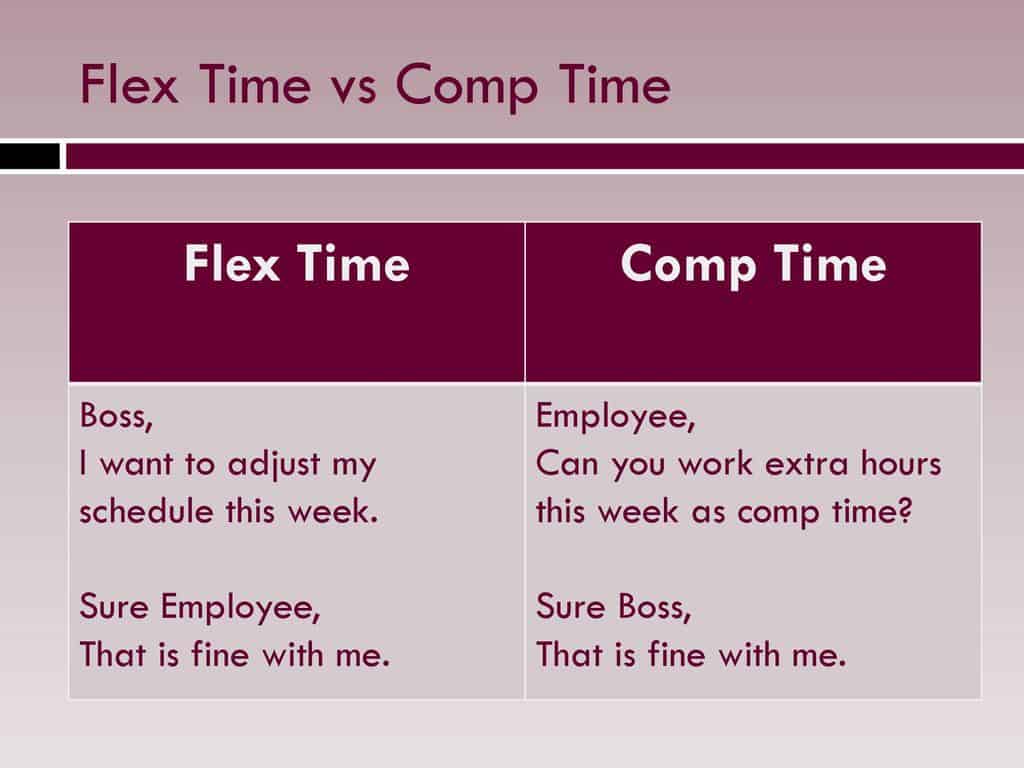Imagine having the freedom and flexibility to structure your workday as you see fit. To start early or late, take longer breaks, or even opt to work weekends instead of weekdays - all while still keeping up with your responsibilities. This is the reality of flex time.
But what is flex time exactly?
In this article, we'll discuss what flex time is, how companies can implement it, plus answer the real question - if it actually works.
Table of Contents
- What is Flex Time and How Does it Work? | Flex-time Meaning
- What Should a Flex Time Policy Include?
- Flex Time vs. Comp Time
- Flex Time Examples
- Pros and Cons of Flex Time
- Key Takeaways
- Frequently Asked Questions
What is Flex Time and How Does it Work? | Flex-time Meaning
Flex time, also known as flexible work hours, is a scheduling arrangement that allows employees some level of flexibility in determining their working hours each day or week.
Rather than working a standard 9-5 schedule, flex time policies give workers more autonomy over when they complete their work.

How it works:
• Core hours: Flex time schedules define a set period in the morning and afternoon that constitutes "core hours" - the timeframe when all employees must be present. This is usually around 10-12 hours per day.
• Flexible window: Outside of core hours, employees have the flexibility to choose when they work. There is typically a flexible window where work can start earlier or end later, allowing staffers to stagger their hours.
• Fixed schedule: Some employees may work fixed schedules, coming in at the same time each day. However, they have flexibility within the window to modify their lunch or break times.
• Trust-based system: Flex time relies on an element of trust. Employees are expected to track their hours and ensure deadlines are hit, with oversight from managers.
• Pre-approval: Requests to work significantly different schedules each day usually need manager approval. However, flexibility within core hours is normally allowed.
Flex time is beneficial as it allows a better balance of personal and professional responsibilities. As long as the work gets done, when and where it happens is up to individual circumstances and preferences.
What Should a Flex Time Policy Include?

A well-written flex time policy should include the following key elements:
- Purpose and Scope - State why the policy exists and who is eligible to participate.
- Core/Required Work Hours - Define the window when all staff must be present (e.g. 10 AM-3 PM).
- Flexible Work Schedule Window - Specify the timeframe outside core hours when arrival/departure can vary.
- Notification Requirements - Outline when staff must inform managers of planned schedule changes.
- WorkDAY Parameters - Set limits on minimum/maximum hours that can be worked daily.
- Schedule Approval - Detail the approval process for schedules outside standard windows.
- Time Tracking - Explain overtime pay rules and how flexible hours will be tracked.
- Meal and Rest Breaks - Define flexible break structure and scheduling options.
- Performance Evaluation - Clarify how flexible schedules fit with performance and availability expectations.
- Communication Standards - Set rules for communicating schedule changes and contactability.
- Remote Work - If allowed, include telecommuting arrangements and technology/security standards.
- Schedule Changes - State the notice required for resuming/changing a flexible schedule.
- Policy Compliance - Explain the consequences of not adhering to flex time policy terms.
The more you're thorough and detailed, the better your employees understand your flex time policy and know what to expect. Remember to set a team meeting to communicate the policy transparently and see if any confusion and questions need to be answered.
Communicate Effectively with AhaSlidesNew policies need time to adopt. Exchange information in a crystal clear manner with engaging polls and Q&A.
Flex Time vs. Comp Time
Flex time is generally different from comp time (or compensation time). Flex time provides daily scheduling flexibility while comp time offers time off in lieu of cash overtime pay for extra hours worked.

| Flex time | Comp time (Compensation time) |
| • Allows flexibility in daily start/end times within set parameters. • Core hours are set when all must be present. • Flexible window provides scheduling options outside core hours. • Employee chooses the schedule in advance. •Hours are tracked and overtime rules still apply if weekly limits are exceeded. • Pay remains the same regardless of schedule. | • Applies when an employee works overtime hours beyond their standard schedule. • Instead of paid overtime, the employee receives compensatory time off. • Each extra hour worked earns 1.5 hours of comp time for future use. • Comp time hours must be used/paid out by certain deadlines. • Used by public employers unable to provide cash overtime pay. |
Flex Time Examples
Here are some examples of flexible work schedules employees could request under a flex time policy:
Compressed Work Week:
- Work 10 hours every day, Monday to Thursday, with Friday off. This spreads 40 hours over 4 days.
During the busy season, an employee may work 10-hour days (8 am-6 pm) Monday through Thursday to have every Friday off for long weekend trips.
Adjusted Start/End Times:
- Start at 7 am and finish at 3:30 pm
- Start at 10 am and finish at 6 pm
- Start at 12 pm and finish at 8 pm
An employee may choose to work from 7 am to 3:30 pm, Monday through Friday. This allows an earlier start to beat morning commuter traffic.
A worker can come to work from 11 am to 7:30 pm instead of traditional hours since they have evening obligations like childcare three days a week.

Weekend Schedule:
- Work Saturday and Sunday from 8 am to 5 pm, with Monday to Friday off.
Weekend schedules work well for roles like customer service that require coverage on those days.
Staggered Hours:
- Start at 7 am on Tuesdays and Thursdays, but 9 am on Mondays, Wednesdays, and Fridays.
Staggered hours spread employee traffic and allow service coverage across more hours each day.
A manager can schedule morning meetings from 9-11 am as "core" hours, but teams set flexible hours outside of that window as needed.
9/80 Schedule:
- Work 9 hours for 8 days each pay period, with an alternating day off every other Friday.
The 9/80 schedules grant every other Friday off while still working 80 hours in two weeks.
Remote Work:
- Work remotely 3 days a week from home, with 2 days in the main office.
Remote workers can check in during core “office” hours but schedule other duties freely as long as their projects stay on track.
Pros and Cons of Flex Time
Thinking about implementing flex time hours? Check out these pros and cons for the employees and the companies first to see if it's the right fit:
For the Employees

✅ Pros:
- Improved work-life balance and less stress from scheduling flexibility.
- Increased productivity and morale from feeling trusted and empowered.
- Savings on commuting costs and time by avoiding or reducing rush hour traffic.
- Ability to better manage personal and family responsibilities.
- Opportunities to further education or pursue other interests outside standard hours.
❗️Cons:
- Increased feeling of being "always on" and blurring of work-life boundaries without proper communication boundaries.
- Social isolation working non-standard hours without teammates around.
- Childcare/family commitments may be difficult to coordinate around a variable schedule, such as if you're working on the weekend and taking weekdays off.
- Fewer opportunities for impromptu collaboration, mentorship and career development.
- Potential schedule conflicts during core hours required for meetings and deadlines.
For the Employers

- Attraction and retention of top talent by offering competitive benefits.
- Reduction in overtime costs by allowing flexible scheduling within a 40-hour workweek.
- Increased engagement and discretionary effort from happy, loyal employees.
- Possible expansion of hours for client/customer service coverage without adding headcount.
- Lower operational costs like real estate by enabling remote work options.
- Enhanced ability to recruit talent from a wider geographic area.
- Improved job satisfaction, motivation and job performance among staff.
- Reduction in absenteeism and use of sick/personal time off.
- Higher administrative burden to track flexible hours, approve schedules, and monitor productivity.
- Loss of informal collaboration, knowledge sharing and team-building during typical hours.
- Costs associated with enabling remote work infrastructure, collaboration tools, and scheduling software.
- Ensuring adequate staff coverage and availability for clients/customers across schedules.
- Reduced efficiency for tasks requiring team coordination and on-site resources.
- Potential system outages or delays accessing resources during off-hours support.
- Harsher shifts may impact retention for jobs not naturally compatible with flexibility.
Key Takeaways
Flexibility does introduce some complexities. But when designed and implemented properly, flex time schedules provide a win-win for both parties through increased productivity, cost savings and elevated morale.
Making collaboration tools available regardless of location or hours helps flex time succeed through effective communication and coordination. Tracking time also eases overhead.
Frequently Asked Questions
What is the meaning of Flexitime?
Flexi-time refers to a flexible work arrangement that allows employees some flexibility in choosing their working hours, within set limits.
What is flex time in tech?
Flex time in the tech industry generally refers to flexible work arrangements that allow professionals like developers, engineers, designers, etc. to set their own schedules within certain parameters.
What is flex time in Japan?
Flex time in Japan (or Sairyo Rodosei) refers to flexible working arrangements that allow employees some autonomy in deciding their work schedules. However, flexible work practices have been slower to take hold in Japan's conservative business culture which values long working hours and a visible presence at the office.
Why use flex time?
Like all the pros above, flex time usually improves both business outputs and quality of life for professionals when implemented successfully.








